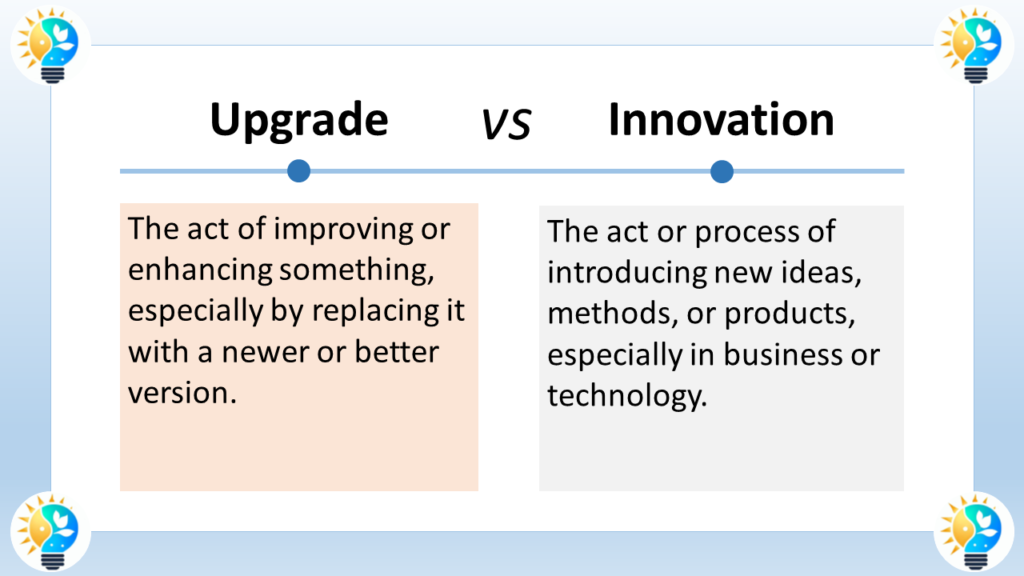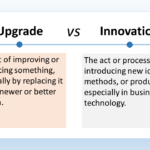The difference between upgrade and innovation lies in the scope and impact of the change being made.
An upgrade refers to making something better by adding or improving features
Innovation involves creating something completely new or significantly altering the way something is used or produced.

Definition
Upgrade
Upgrade is the act of enhancing or improving an existing product, system, or service by adding new features or components.
- Characteristics of Upgrade:
- Incremental Improvement: Refers to small, iterative enhancements.
- Compatibility: Maintains fundamental design and functionality while improving performance.
- Familiarity: The upgraded entity remains recognizable and operates in a similar manner as before.
Innovation
Innovation is the introduction of new ideas, products, services, or processes that significantly change or create new markets, paradigms, or industries.
- Characteristics of Innovation:
- Novelty: Involves a substantial degree of newness and originality.
- Disruption: May change or create new markets or ways of doing things.
- Value Creation: Generates significant value or improvement over existing options.
More Synonyms on innovation, innovate and innovative
Innovation Terms

Innovation is considered as a driving force in progress.
It includes the introduction of novel ideas, methods, or products that bring positive change and advancement.
For more information about innovations, check our glossary
Relationship and Relevance
While an upgrade can be a component of innovation, not all upgrades are innovative. Upgrades typically refine and optimize existing solutions, whereas innovation can introduce radical changes that redefine a product or service. Both play important roles in technological and business development, but their scopes differ greatly.
Based on the information provided in the search results, the key differences between upgrade and innovation are:
Upgrade
- Upgrading refers to making incremental improvements or enhancements to existing products, processes or systems.
- It involves optimizing and refining what already exists, making it more effective or efficient.
- Upgrades build on current knowledge and resources to achieve better results through small, iterative changes.
- Upgrading has a lower failure rate as it builds on established foundations.
Innovation
- Innovation refers to the creation of something entirely new - a novel product, service, process or business model.
- It involves a more radical, disruptive approach that challenges the status quo and explores uncharted territories.
- Innovation is driven by a desire to do things differently rather than just better, often based on visionary foresight.
- Innovations have a higher failure rate as they involve greater uncertainty and risk-taking, but can also have greater potential impact.
In summary, upgrading is about making incremental improvements to existing solutions, while innovation is about creating fundamentally new solutions. Upgrades optimize and refine what already exists, while innovations introduce something completely novel. Both upgrading and innovating are important, but they represent distinct mindsets and approaches. The most effective organizations are able to balance and leverage both as needed.
Context for Using Each Term
- Upgrade is used when discussing enhancements to existing technology, software, services, or systems that make them better or more efficient.
- Innovation is used when talking about the larger process of creating fundamentally new solutions or the significant evolution of current practices that have a major impact on how things are done.
Example of Utilization
A smartphone receiving a new software update with improved camera functionality and battery life is undergoing an upgrade. When a company develops a new smartphone with a foldable screen that challenges the conventional smartphone design and usage, it is an innovation.
In essence, an upgrade is about making something better, often in expected or familiar ways, while innovation is about making something different, which can lead to unexpected and transformative outcomes.
FAQ
Q: Can an upgrade lead to innovation?
A: While less common, a series of upgrades over time could potentially result in a significant enough change to be considered an innovation.
Q: Are innovations always better than upgrades?
A: Not necessarily. The choice between upgrade and innovation depends on specific needs, resources, and goals. Sometimes, steady upgrades are more appropriate and effective.
Q: How do upgrades and innovations contribute to progress?
A: Upgrades ensure continuous improvement and relevance of existing systems, while innovations introduce new solutions that can lead to significant leaps in progress.
Q: Can a product receive both upgrades and innovations simultaneously?
A: Yes, a product can undergo regular upgrades while also incorporating innovative features or technologies.

